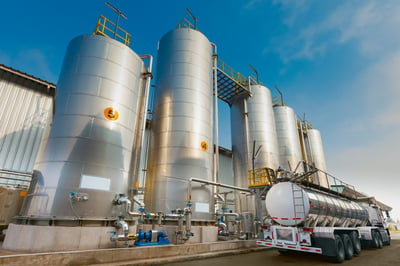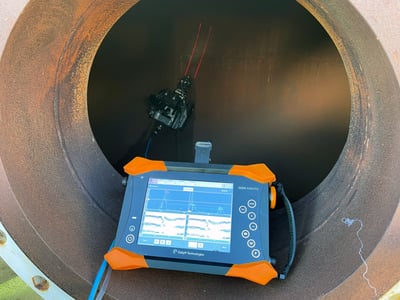What is an Explosive Atmosphere?
An explosive atmosphere refers to a highly hazardous environment characterized by the presence of flammable substances, including gases, vapors, or combustible dust, in concentrations that can potentially lead to an explosion if ignited. This potentially dangerous situation poses significant risks to human safety, infrastructure, and the surrounding environment.
The primary factor contributing to the formation of an explosive atmosphere is the presence of substances that can rapidly release energy when combined with an ignition source. Gases and vapors, such as methane, propane, butane, or hydrogen, can accumulate in confined spaces or escape from pressurized systems, creating a potentially explosive mixture in the air.
Combustible dust can also contribute to the formation of an explosive atmosphere. Fine particles of various materials, like coal, wood, flour, or metals, can become suspended in the air, forming a combustible mixture. When exposed to an ignition source, such as sparks, flames, or hot surfaces, these dust clouds can trigger a rapid combustion process leading to explosions.
What is ATEX?
ATEX (Atmosphères Explosibles) is a comprehensive regulatory framework established by the European Union to effectively manage and mitigate the risks associated with explosive atmospheres. This directive plays a crucial role in safeguarding the health and safety of individuals working in environments where explosive substances may be present.
The primary objective of ATEX is to establish stringent guidelines and harmonized standards that ensure the proper design, manufacturing, and use of equipment intended for deployment in potentially hazardous areas. By setting out clear requirements, ATEX aims to prevent the occurrence of explosions, fires, and other dangerous incidents that could arise from the ignition of flammable substances.
To achieve compliance with ATEX, manufacturers and suppliers must adhere to specific technical and safety standards outlined in the directive. This includes conducting thorough risk assessments, designing equipment to prevent ignition sources, implementing appropriate protective measures, and providing clear instructions for safe installation, operation, and maintenance.
Certification plays a pivotal role in the ATEX compliance process. Equipment that successfully meets the requirements set forth in the directive receives certification, indicating its suitability for use in potentially explosive environments. This certification assures employers, regulatory bodies, and workers that the equipment has undergone rigorous testing and conforms to the highest safety standards.
What are the different types of Explosive Atmospheres (ATEX Zones)
To try and make our job a little easier, ATEX has broken down explosive atmospheres into three categories for flammable gases:
|
Zone Classification for Gases |
|||
|
Zone 0 |
The part of a hazardous area in which a flammable atmosphere is continually present or present for long periods. |
||
|
Zone 1 |
The part of a hazardous area in which a flammable atmosphere is likely to occur in normal operation. |
||
|
Zone 2 |
The part of a hazardous area in which a flammable atmosphere is not likely to occur in normal operation and, if it occurs, will exist for a short period. |
||
|
The zoning above does not cover areas where combustible dust may be present, but a three-zone approach (Zones 20, 21, and 22) has been adopted for dust. |
|||
|
Zone Classification for Dusts |
|||
|
Zone 20 |
A place in which an explosive atmosphere, in the form of a cloud of combustible dust in air, is present continuously, or for long periods or frequently for short periods. |
||
|
Zone 21 |
A place in which an explosive atmosphere, in the form of a cloud of combustible dust in air, is likely to occur occasionally in normal operation. |
||
|
Zone 22 |
A place in which an explosive atmosphere, in the form of a cloud of combustible dust in air, is not likely to occur in normal operation but, if it does occur, will persist for a short period only. |
||
More information is available here.
What does Intrinsically Safe mean?
Intrinsically safe, often abbreviated as "IS," is a crucial concept in industries where potentially explosive atmospheres are present. It defines a set of stringent safety standards and principles applied to electrical and electronic equipment to minimize the risk of ignition and subsequent explosions in such hazardous environments.
Intrinsically safe equipment, achieved through careful design, construction, and certification processes, ensures that it is incapable of generating sparks, arcs, or temperatures high enough to ignite flammable substances in the surrounding atmosphere. The primary objective is to limit energy levels to prevent explosions, even under fault conditions. This is accomplished by implementing protective measures such as specialized components and materials that do not produce sparks, encapsulating potential ignition sources, utilizing current-limiting techniques, and incorporating robust safety barriers.
Operational Considerations
Considered Explosive Atmospheres
Industries such as oil refineries, chemical plants, offshore platforms, mines, and grain silos are particularly prone to the formation of explosive atmospheres due to the nature of their operations and the materials they handle.
Oil refineries, for instance, deal with volatile substances such as petroleum and its byproducts. The refining process involves various stages that can release flammable gases, vapors, or mists into the air. Similarly, chemical plants handle numerous chemicals that have the potential to create explosive atmospheres if not handled properly. The storage, mixing, and processing of these substances can generate combustible dust, gases, or fumes, which can ignite under certain conditions.
Offshore platforms face unique challenges due to their location in remote areas and the presence of flammable gases and liquids. The extraction and processing of oil and gas in offshore environments require sophisticated equipment and stringent safety measures to prevent accidents and protect personnel.
Mines are another setting where explosive atmospheres can arise, particularly in underground mining operations. The extraction of minerals like coal or metals can release methane gas, coal dust, or other combustible substances. The confined spaces and limited ventilation systems in mines further increase the risk of explosive atmospheres.
 Grain silos, commonly used for storing grains and agricultural products, are prone to the formation of explosive atmospheres due to the accumulation of combustible dust. Fine particles from grains can become suspended in the air, creating a highly flammable mixture that can ignite if exposed to an ignition source.
Grain silos, commonly used for storing grains and agricultural products, are prone to the formation of explosive atmospheres due to the accumulation of combustible dust. Fine particles from grains can become suspended in the air, creating a highly flammable mixture that can ignite if exposed to an ignition source.
In these industrial settings, preventing ignition is of paramount importance to ensure the safety of workers and the surrounding environment. Equipment deployed in these environments must be designed and constructed to minimize the risk of ignition. Electrical systems, lighting fixtures, motors, and other equipment must be carefully selected and installed to prevent sparks or heat that could ignite the surrounding atmosphere.
Additionally, strict safety protocols, such as the implementation of proper ventilation systems, regular inspections, and maintenance, are crucial to minimize the formation and concentration of flammable substances. Training programs and awareness campaigns are essential to educate personnel about the potential risks and appropriate safety practices.
By understanding the unique challenges posed by explosive atmospheres and implementing comprehensive safety measures, industrial facilities can reduce the risk of accidents, protect workers, and safeguard the surrounding environment.
Where do robotic systems get used?
Robotic systems have found wide-ranging applications across various industries and sectors. These advanced technologies are utilized in a multitude of settings where their precision, efficiency, and adaptability provide significant advantages. One prominent area where robotic systems are employed is in hazardous environments, enabling tasks such as inspection, maintenance, and monitoring to be conducted safely and effectively.
In the field of industrial inspections, robotic systems have revolutionized the way critical assets are assessed and evaluated. For instance, in the oil and gas industry, pipelines are subject to regular inspections to identify any structural weaknesses, corrosion, or leaks. Eddyfi Technologies’ inspection crawlers can navigate pipelines, collecting high-resolution images, conducting non-destructive testing (NDT), and detecting anomalies with precision. They can operate in challenging conditions, including harsh weather, high-pressure environments, and remote locations, reducing the need for human intervention in potentially hazardous situations.
Similarly, inspection crawlers are employed for tank integrity assessments, where they can enter confined spaces and examine the storage tanks used in industries such as petrochemicals, food processing, and wastewater management. By utilizing robotic technologies, these inspections can be performed more efficiently, accurately, and safely, minimizing risks associated with human entry into hazardous environments.
Offshore platforms, including drilling rigs and production facilities, also benefit from the deployment of inspection crawlers. These platforms often operate in demanding conditions, such as extreme temperatures, corrosive environments, and high-pressure zones. Robotic systems enable routine inspections, maintenance tasks, and repairs to be carried out without exposing human workers to potential hazards, enhancing overall safety and reducing operational downtime.
Furthermore, the mining industry relies on robotic systems to optimize operations and ensure the safety of workers. Robotic equipment can be used to inspect and assess mining equipment, identify potential malfunctions, and collect data on productivity and efficiency. They can also be employed in hazardous mining environments to handle dangerous substances or explore areas that are inaccessible or pose risks to human miners. Similarly, NDT scanners are being used to monitor storage tanks found in the mining industry.
The Wider Landscape
When it comes to equipment used in potentially explosive atmospheres, the presence of an "Ex sticker" serves as an indication that the equipment adheres to certain hazardous area standards. However, it's important to note that this labeling alone does not automatically guarantee ATEX certification. Achieving ATEX compliance requires undergoing comprehensive testing, which involves specific procedures designed to assess EX ratings. These rigorous measures are put in place to ensure the safety and reliability of equipment deployed in potentially explosive environments.
If equipment bears an "Ex" mark, which denotes explosion protection, it should also be appropriately marked with code certification. This certification includes information such as explosion protection demarcation, protection concepts, gas group, and temperature classification. These markings are specific to the equipment and are determined through testing or assessment by a competent individual in accordance with BS EN 60079 Part 17: Explosive Atmospheres. Any modifications to the equipment, including changes to the power supply, attached sensors, traction system (wheels, tracks), addition of spare parts, or wear parts, would require re-assessment and re-certification.
To provide further clarity on where equipment can be used in specific potentially explosive atmospheres, ATEX in Europe has established specific markings that indicate the type of environment in which a particular piece of equipment is suitable for use. HSE defines areas that may have explosive atmospheres, such as paint spray booths, fuel tanks, sumps, and other places where aerosols, vapors, mists, gases, or dusts exist. These areas require different treatment and must undergo risk assessment in accordance with the Dangerous Substances and Explosive Atmospheres Regulations 2002 (DSEAR). HSE has produced guidance on DSEAR to facilitate compliance with these regulations. Additionally, precautions should be taken to prevent static discharges in potentially explosive atmospheres, including measures such as earth bonding and the selection of antistatic work clothing and footwear.
Before operating within a hazardous or potentially explosive atmosphere, it is crucial to understand what a system has been tested for, how it was tested, and where it can be safely used. This knowledge ensures compliance with regulations and helps maintain safety in such environments.
Eddyfi Solution/EX Zone Deployment
Eddyfi Technologies recognizes that its equipment is not intrinsically safe or ATEX-rated. Instead, the company follows a specific approach when operating in explosive atmospheres. Eddyfi Technologies conducts testing under a hot work permit, accompanied by a comprehensive risk assessment. The company's main focus is to establish procedures and offer support for risk assessment, aiming to contribute to the transformation of the health and safety executive (HSE) process and enhance the understanding of associated risks.
Due to the nature of NDT equipment, including its form factor and use cases, achieving a cost-effective or practical ATEX-rated solution is challenging. Consequently, there are no ATEX-rated instruments available for ultrasonic testing (UT), eddy current (EC), or visual testing (VT) combined. Hence, when operating in explosive environments, particularly Zone 0, 1, and 2, Eddyfi Technologies robotics equipment is predominantly used under a hot work permit with an associated risk assessment.
While Eddyfi Technologies continuously strives to improve its products and services, there are currently no plans in the short or mid-term to introduce ATEX-rated equipment. The practicality aspect also poses a challenge, as each system, including the crawler, controller, UT set, and related attachments, would need to be individually rated for ATEX, considering different orientations and configurations. Unfortunately, this option is not currently viable within our industry.
However, Eddyfi Technologies is committed to assisting in defining procedures and providing support for risk assessments across various applications. By doing so, the company aims to contribute to the reshaping of the HSE process and enhance the understanding of associated risks.
Risk Management
An example risk assessment for deploying Eddyfi Technologies' equipment in explosive environments would involve assessing the potential ignition sources, implementing proper safeguards, and defining procedures for safe operation. This risk assessment ensures that the necessary precautions are taken to minimize the risks associated with operating in hazardous areas.

Safety for Human Inspection vs. Safety for Robotics (Assumed Risk)
When comparing safety considerations for human inspections and robotic operations in explosive atmospheres, it is essential to recognize the inherent risks associated with human presence. While precautions are taken to ensure the safety of robotic systems, the use of automation can reduce human exposure to potential dangers, thus minimizing the risk to human life.
Conclusion
Eddyfi Technologies understands the complexities of non-destructive test equipment and the challenges posed by ATEX certification. While the company constantly seeks to improve its products and services, there are currently no short or mid-term plans to introduce ATEX-rated equipment. Instead, Eddyfi Technologies focuses on providing support for risk assessments and reshaping HSE processes to ensure safe operations in explosive atmospheres. By leveraging robotic systems, industries can enhance safety, efficiency, and accuracy in hazardous environments. You can visit the HSE website and review topics relating to fire and explosion here. Still have questions? We invite you to get in touch to discuss with our experts dedicated to keeping you Beyond Current.





